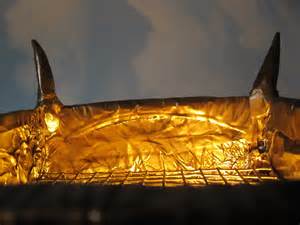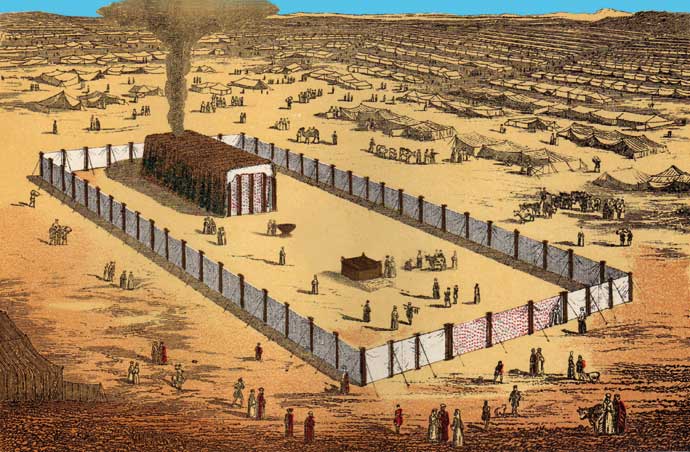The Brazen or the Bronze Altar is still our focus. Here are the verses again:
“Using acacia wood, construct a square altar 7½ feet wide, 7½ feet long, and 4½ feet high. Make horns for each of its four corners so that the horns and altar are all one piece. Overlay the altar with bronze. Make ash buckets, shovels, basins, meat forks, and firepans, all of bronze. Make a bronze grating for it, and attach four bronze rings at its four corners.” Exodus 27:1-4 NLT
We don’t read about crowd control or how they managed the line or, if you like – the queue. There is no mention of a take-a-number system and wait-your-turn but be sure of this – the bronze altar was a busy altar. It wasn’t an altar that was only visited on Jewish festivals or active on a weekly basis. This altar had non-stop daily activity.

Let’s compile an incomplete list of occasions when this altar was in use for sacrifices:
- A lamb was offered every morning and evening on this altar. Exodus 29:39
- Two lambs every Sabbath. Numbers 28:9
- Two bulls, one ram and seven lambs at the beginning of every month. Numbers 28:11
- Every annual Passover Festival – multiple sacrifices; and other Jewish festivals. Numbers 28:16
- When any individual person became aware of their sin or a specific wrongdoing or their need to fulfill the requirements of the law – as frequently as required. (Leviticus) Mandatory sacrifices.
- When any Israelite personally desired in their heart to voluntarily offer up a sacrifice. Voluntary sacrifices.
The point here is not to study the sacrifices; that’s a major study for some other time. The point here is to make an impression of how busy and how significant the Bronze Altar was. Non-stop, continual traffic. How could anyone miss seeing the absolute importance and inescapable necessity of approaching God in worship by way of the altar of sacrifice – the blood of the Lord Jesus Christ!
But look at the striking difference in Hebrews Chapter 10 – since the Lord Jesus Christ came to earth and went to the cross.
“For it is impossible for the blood of bulls and goats to take away sins. Consequently, when Christ came into the world, he said, “Sacrifices and offerings you have not desired, but a body have you prepared for me; in burnt offerings and sin offerings you have taken no pleasure. Then I said, ‘Behold, I have come to do your will, O God, as it is written of me in the scroll of the book.'” When he said above, “You have neither desired nor taken pleasure in sacrifices and offerings and burnt offerings and sin offerings” (these are offered according to the law), then he
added, “Behold, I have come to do your will.” He does away with the first in order to establish the second. And by that will we have been sanctified through the offering of the body of Jesus Christ once for all. And every priest stands daily at his service, offering repeatedly the same sacrifices, which can never take away sins. But when Christ had offered for all time a single sacrifice for sins, he sat down at the right hand of God, waiting from that time until his enemies should be made a footstool for his feet. For by a single offering he has perfected for all time those who are being sanctified.” Hebrews 10:4-14 ESV
You can’t see these two words over the cross, but think about them and what they could possibly mean: sufficiency and satisfaction.
The Altar of the Burnt Sacrifice – the Bronze Altar was not only busy; it was bloody! Israelites would lead their perfect lamb or goat or bull to the door of the Tabernacle Courtyard to be met by the priests. The offeror would place his hands on the head of the animal he brought and then slay his animal. The priests would catch the blood in a basin and offer the blood as an atonement. The priests would splash the blood on the altar and pour the remaining blood in the basin at the base of the Bronze Altar. The slain animal would then be carved up into pieces, and parts washed and then the various pieces would be tied to the horns of the altar and be burned.
When you hear the hackneyed expression – “all the rivers of blood that flowed from Jewish altars,” you will now have a better appreciation of how much blood was shed every day over the centuries until Jesus came and shed His own blood that could put away sin forever.
Perhaps you could Google and learn this old hymn written by Isaac Watts several centuries ago:
Not all the blood of beasts
On Jewish altars slain
Could give the guilty conscience peace
Or wash away the stain.
But Christ, the heavenly Lamb,
Takes all our sins away;
A sacrifice of nobler name
And richer blood than they.
What about those four horns on the altar? It seems that parts of the slain animal were tied to the horns of the altar. Check out Psalm 118:27. “Horns were a symbol of power and strength in biblical times. When the sacrifice was made, blood was dabbed on the horns of the altar, signifying the power of the blood to atone for sins. In the same way, there is mighty power in the blood of Christ. Jesus is the “horn of our salvation” (Psalm 18:2, Luke 1:69).” (1)
The sacrifice is tied to the horns. Think of the Lord Jesus and His total commitment to carry out His Father’s will by allowing Himself to be nailed to the cross for our sins. Read the verses above from Hebrews Chapter 10 once again and notice the reference to Jesus doing God’s will.
David Levy writes: “The blood-stained horns pointed upward and outward to the four corners of the world, reminding us of the saving power of Christ’s blood that will be witnessed throughout the world. (Acts 1:8)
Finally, let’s think about the bronze grate network inside the Bronze Altar. We know it was halfway down, inside the 4 ½ feet high box. (Exodus 27:4,5) We also know that bulls and other animals were too heavy for any one person to lift up and place on the altar. So the animal was carved up, and its pieces were lifted up by special bronze hooks (Exodus 27:3) and lowered onto the bronze shelf-like grate that was halfway down inside the box. There it would be burned.

The animal carved up in pieces (because the entirety of the animal could never be carried by anyone) – may suggest that we could never appreciate or wrap our heads or hearts around the entirety of Christ – and all there is to appreciate about Him. His ‘unsearchable riches’ and the ‘unspeakable gift.’ The world itself could not contain the books that could be written about Him. We can only appreciate Him in ‘part.’
The grate was specifically at the halfway point of the 4 ½ high box – which is the same height or level as the ark and the mercy seat inside the Holiest of Holies which we will study in another lesson. Dr. A. J. Higgins makes this observation: “The work which enabled the sinner access, as typified in the brazen/bronze altar, is the same work that secures the Presence of God with all its attendant blessings.” Mull that one over in your mind!
The grate, halfway down inside the box with the pieces of the animal burning on it – probably meant the Israelites couldn’t actually see much of the fire that consumed the sacrifice. We can read about the Cross and stand nearby in our hearts – but we will never know the full extent of His sufferings and the fire that burnt at Calvary.
Are you beginning to see how clearly Christ can be seen and appreciated by studying the ancient tabernacle?
Sources:
- http://the-tabernacle-place.com/articles/what_is_the_tabernacle/tabernacle_brazen_altar
David M. Levy, The Tabernacle – Shadows of the Messiah, p.22
Dr. A. J. Higgins, Monday Meditations
Henry W. Soltau, The Holy Vessels and Furniture of the Tabernacle, Kregel Publications


WOW! I knew Christ was in the Tabernacle but I didn’t realize how much.
I’m impressed, too, with how much was made of bronze, which was able to withstand extreme heat needed for carrying out the procedures the priests were commanded to follow. To think that God prepared the properties of that metal at the beginning of time so it could someday be used in the Tabernacle and the Temple is really meaningful to me.